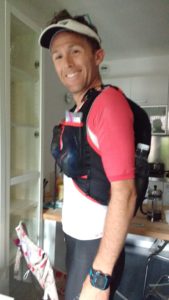
All ready for a long training run with my Euro tight clothing and vest full of all the required gear.
I am more prepared for this race than for any ultra marathon I have ever raced. I’ve run hundreds of miles on the course. I have done race-specific training like never before. I’ve been running with this god-awfully heavy pack of required gear for well over a month now. I’m tapering into form at just the right time. I’m downright ready to get out there and do this thing!
It’s been a long process and I’ve had lots of time to think about UTMB 2016. Here are some of the highlights that are leading into this big event:
Training
I have had a few key things go my way this time around that has not been the case for prior events. First, I don’t have any other big projects currently such as work, school, or a CFA exam to alter my training. Granted, we have an 8 month old baby so I don’t train all day, everyday, whenever I want. However, I have been able to train consistently and specifically – and maybe the nightly wakeups (Paavo usefully only sleeps in 3 hour chunks) will make being up and moving at 4am a little less bad!
We had two months of running at higher altitude in Mexico in May and June. While not overly specific (or even necessary), it felt good adapting to that situation. I did primarily easy running while building mileage and staying consistent.
We arrived in the Chamonix Valley on July 6th and found out that the studio chalet we’d booked months in advance was literally at the bottom of the first climb of the UTMB course. This became an important part of my training.
Key training elements:
- Long days on the trails simulating race day. I had five big days on the trails carrying the full required kit along with food to last for the entire long run. My max day was a 52 miler over 13 hours and more than 15,000’ of climbing. I’ve never had training like this and I feel way more prepared for all the ups and downs, and all the hiking that plays a big part in this event.
- Speed days. I had a weekly speed workout that I have stuck with since late June. I did some shorter, faster work early on focusing on efficiency and form. I did some aerobic endurance work. And then I finished up with some anaerobic threshold training with hard intervals on trails with a focus on uphills. As a result, I still feel fast, despite all the long slow miles.
- Shorter race simulation days. I did that hill outside our chalet numerous times. It would net me around 2,500’ of climbing per night, 8 miles round trip. I would hike up with a full kit (often with a fully belly after dinner) and I’d easy jog down. It was not a tough day, but the end result is that I feel comfortable and chill doing steep, long climbs. My legs aren’t getting wiped out by the ups, and more importantly, I’m not totally wrecked or tired after the steep descents.
- Mileage. I’ve kept up my running streak (now well over 300 days) and my mileage has averaged close to 90 miles per week for the past six weeks. I feel like I recover quickly and while injuries can always happen, I feel tough and as injury-proof as I’m going to be at this point in the season.
With all this prep work, I feel physically ready. I’m mentally more psyched than ever too, knowing that I’ve put in the work.
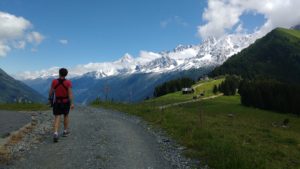
A view from the top of the first big climb
Gear
I’m always preaching to the runners I work with to practice with what they plan to use on race day. I have been taking that to the extreme here, often having weeks of training with 4+ days per week wearing my racing outfit and carrying all my required gear. I’ve grown quite fond of these things and feel like I know them well. I’m also eager to be done carrying all this stuff around!
Nike Wildhorse 3 – Switched from wearing Hokas. I wanted to feel a little closer to the ground while still having some cushion and protection from the rocks. I’ve been happy with the Wildhorse. I’ve worn Nike for my road shoes for over a decade and this is their first trail shoe that is working for me. The pair I arrived in Chamonix with was dying and I couldn’t find a new pair in any of the shops. I tried the local favorite, Salomon, with their Wings trail shoe. After a few runs, I was feeling heel pain and feared plantar fasciitis. Thankfully, Julie came to the rescue and figured out how to order shoes online here in France. Crisis averted, I have a fresh pair for the race!
Salomon S-Lab 12L vest – It’s a big pack with some thick material. It’s also stretchy and form fitting, which means it bounces minimally while I run. It’s been doing the job and fits well, even though it’s more than I want to be wearing. If it’s hot out, it could be more burdensome than normal.
Garmin 920xt watch with heart rate monitor – I love this watch. This summer I switched to tracking my efforts in kilometers and meters rather than miles and feet and it’s funny, but it’s made a difference in being cool being so slow! I don’t have a good frame of reference for pacing in kms so I’ve figured out what I need for a solid UTMB effort, and that is now my guide. I also track heart rate and I have a good sense for what is too hard for this course.
Salomon running tights – Using some simple “man-pri” black tights that descend to just below my knees. The UTMB rule is that we need pants or a combo of tights and calf sleeves to totally cover the leg (this requirement is in addition to the waterproof trousers). I have a pair of calf sleeves that I bought here, that I’ve never used and never intend to, that together achieve the requirement. I actually like the tights feel. I wear a pair of old running underwear with them – I tried one long run without it and chaffage was far worse with the no underwear method.
A tight Euro shirt – Don’t know the brand and found it on the sales rack at Ravanel sports in Chamonix. It’s tight, it’s got holes for venting, yet it’s somehow sort of warm when it’s rainy and cold out. Plus, I feel really Euro with it. With no chafing issues and the psychologic “cool factor” feeling I get from this shirt, it’s a total win.
Seal skin waterproof gloves – Picked these up here in town. I think I’ve finally found gloves that keep my hands warm! I suffer on even mild climate days with cold hands (I think I must have minimal blood flow to them). I’ve worn these in the rain and snow during training runs and my hands have stayed warm. Big win with these.
Ultimate Direction rain jacket – Spent a pretty penny on this one and have only used it a few times. However, it feels great, fits well, and meets the UTMB requirements. I kind of hope for some cold, rainy weather so I can actually use this!
Smartwool long sleeve base layer shirt – 180g tight undershirt. I have kept this in my dry sack through all my training runs and have never needed it. I hope I never need it during the race. It’s a “just in case” piece of gear. It’s comfy to wear in normal life when it’s chilly at least.
Salomon Bonatti waterproof trousers – Another pricey item that helped me meet the gear requirement standards. They seem awesome, but I’ve never been cold enough and wet enough to need them. They’re also in my dry sack and will hopefully never be used.
Petzl NAO – My primary headlamp (I also carry a big back up battery). I’ve used it in many races prior to this one and love it. It only came out a few times in training, but I know it works!
Petzl e+LITE – This little guy (with two CR2032 back up batteries) weighs hardly anything and covers the requirement for a backup “torch”. It’s a sweet little piece of gear that I hopefully will never need.
Other random stuff: A Sea to Summit collapsable cup – maybe I’ll use it for coffee? Otherwise it’s staying in the pack. An emergency blanket – came with the Salomon vest. I’ve never had to use one of these before thankfully. Elastic adhesive bandage – bought at the local pharmacy in Chamonix. Thankfully we only need one meter of it so it’s not too big. Two to four Salomon soft water bottles, depending on how far it is between aid. If it’s not too hot, I’m likely to only carry a liter at a time. Moto G cellphone(s) – One phone, not on airplane mode, with the ability to call for emergency and receive important race notifications via text. I’ll likely carry Julie’s phone too so that I can listen to music. It’s some extra weight, but I don’t have a small mp3 player and music has been awesome at times in past long races and on some of my training runs. Ibuprofen – some days my knees need a little help; essential part of the kit. Duct tape – just a little, just in case.
Food and fueling
I’ve been practicing with real food. This is partly because I’m frugal, partly because I like the idea of eating real food, and partly because it simply took us a month or more to figure out that we can order gels here in France online and get them much cheaper than what they are in the local stores. As a result, I have a combo of gels and real food.
I have 33 Gu gels at the ready and will try to spread them out over the course of the race. I had been using PowerGel exclusively for the past few years. I’m sick of them. Gu flavors seem better to me right now (and they are finally vegan). I used PowerGel because they were more liquidy and easier to get down. However, I’ll be going slower in this race and should have no problem with the thicker consistency of Gu. Win.
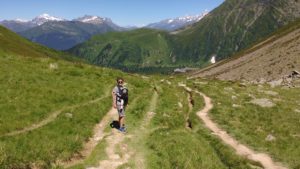
Carrying Paavo up and down 2500 foot climbs has also helped in training – he weighs at least 20 pounds!
For real food I’m going with some things that I’ve concocted based on what has been available here. My go to is a bready-stuffing-crouton thing. Bread is everywhere here. I cut it into roughly one inch cubes and then saute it in olive oil. I then pour over some veggie stock broth over it and cook it a little more until most of the water is out. What is left is a slightly moist, salty, oily, flavorful hunk of bread that goes down easily. I’ve enjoyed it on the trail and have even had it for dinner a few times here.
Tortillas are not great here. However, when I take tortillas, cut them in strips, fry them in oil, and then coat them with cinnamon and sugar, they are fantastic. They are much better warm but I’ve tested them on numerous runs and while not amazing, they work. They will be in a few crew food kits for me along the course.
Raisins and dark chocolate. I didn’t have much in the cupboards here a couple times so I used what I had available. I found that I actually liked it on the run. I’ll have a few small bags of this as well.
I figure I may have a cup or two of coffee along the way in the night. They make it strong here and I figure that the caffeine will be a nice boost in the cold night.
I will likely eat some fruit from aid stations too. Sometimes it sounds so good. If it does, I’ll go for it.
Lastly, I’m still waiting to hear back from the race regarding the “energizing sports drink”. Looking at the sponsor list, Overstim, a UK endurance sport food maker, is one of the main sponsors. I can only assume that they’ll be providing the drinks. Unfortunately, one of their drinks, the one labeled for endurance events, contains milk, so I likely won’t be drinking it. I’m hoping for good news from the race directors soon. Otherwise, I’m going with water.
The Course
I’ve had a chance to run almost half of the course, both the first 45k and the final 40k. I haven’t seen anything in the middle and have yet to step foot in Italy. We didn’t rent a car while here and have been limited to buses and trains (we did find out yesterday that there is a bus to Courmayeur, I had simply never checked!). Regardless, I feel ready, I know what I’m up against, and I have had ample time to practice on the course.
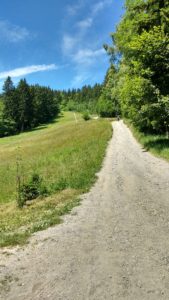
This picture doesn’t show just how steep this early climb is
The climbs are often way steeper than I’m used to and they go on for a long time. I feel way more confident in my hiking abilities now as well as being able to get down without wasting too much energy or getting too beat up. I also realize there are plenty of flatter and smoother sections that are totally runnable. I want to be able to shuffle along on these. I could easily click off kilometers in the 5 to 6 minute range at numerous spots on the course. These can help keep my total average somewhere in the 8’s for kms, and ultimately produce a solid result.
Along with running on the course, I found these videos entertaining and somewhat helpful for getting a sense for what we’ll be up against.
https://www.youtube.com/watch?v=JoqSmmiOTBU
https://www.youtube.com/watch?v=Bot_Va_ix-Y
https://www.youtube.com/watch?v=DgvY7MMPBEo
https://www.youtube.com/watch?v=Y_b4oU3goV8
Lastly, Julie did research for me and read lots of race reports to learn more about the course and how to approach it. These were the top three that we found most helpful:
http://ultrarunningcommunity.com/13-report/198-utmb-race-report-and-thoughts
http://rununtilidie.com/2015-ultra-trail-du-mont-blanc-utmb-race-report-more-than-a-foot-race/
https://ultrarunnergirl.com/2013/09/06/ultra-trail-du-mont-blanc-168-km-race-report/
Race Strategy
With all the gear, the time on the course, and a setting for good training, my thoughts going into the race are optimistic (I have the trail name Optimist, so this shouldn’t come as a surprise). Despite my optimism, the lesson I’ve learned that feels most important to me is that patience is of the utmost importance here. This is a long, tiring race. The climbs, ten big ones along with a few smaller ones (relatively speaking), will take a long time. The descents from these big climbs will hurt. My plan is to be chill for as long as I possibly can. I plan to risk being overly conservative rather than overly aggressive. I have been tired after the first big descent into St. Gervais already during training and I’ve been worked pretty good coming down from Col du Bonhomme. These were valuable lessons. I plan to be just as chill on the downs as I am the ups. My hope is that I can reach the Lac Champex area with some semblance of having legs under me so I can actually be running when possible later in the race. There are plenty of opportunities to be running in the final thirty miles and I hope to be taking advantage of that.
Final thoughts
I don’t have a time goal, but based on my training, I feel like somewhere in the 24 to 26 hour range seems reasonable. Looking at last year’s finish, a time in this range could put me in the top 25 overall. I would be ecstatic with a finish in the top 30. I think people are often overly competitive early here and there is largely a war of attrition going on. If I can show some restraint and self control, always be moving smoothly, not beating myself up and wasting energy, and then have some cajones later in the race when I’m exhausted, then I can have my 100 miler breakthrough that I’ve been steadily chasing for a few years now. I feel like I have a better shot on this one than any before. Here goes!
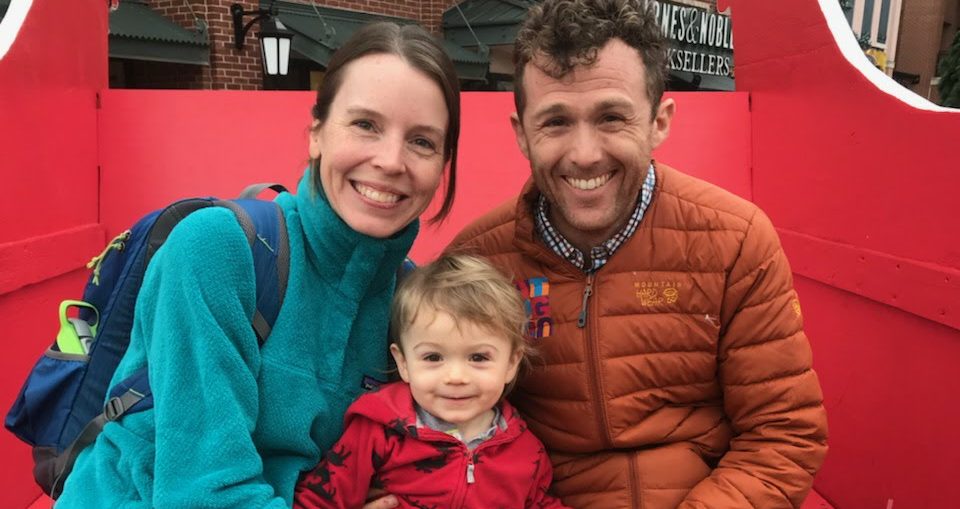










Good Luck Matt! I will be keeping you in my thoughts & prayers for a safe and successful event.
I loved reading your training experience and wish you the best!
Nice! Sounds like you got this one dialed-in pretty well Matt. I’ve heard that the climbs are stout. Man, someday I want to go there and run / hike it. Go get it!